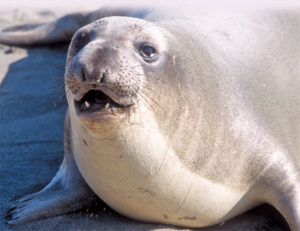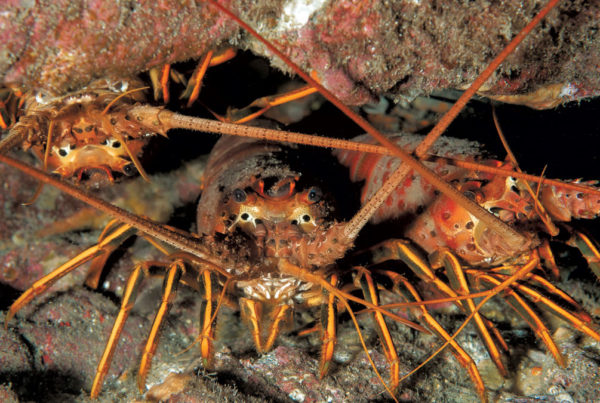This column is a departure from those I’ve done in the past because it features creatures I have never seen underwater.
There are two species of elephant seals, northern and southern. Those found off the West Coast of North America are northern elephant seals (Mirounga angustirostris). The three populations of southern elephant seals (Mirounga leonine) are found in the south Atlantic Ocean, the south Indian Ocean and among the sub-Antarctic islands of the Pacific Ocean. The ranges of the two species do not overlap and they are never found together.
 About Elephant Seals
About Elephant Seals
While I have never seen an elephant seal underwater, I have seen them in rookeries on San Miguel, San Nicolas and Santa Barbara Islands, the Piedras Blancas Light Station and Baja’s San Benito Islands. I am not so sure one or more hasn’t seen me. Underwater the animals are very graceful and quiet. The same cannot be said about them on land, where they use their front and fore flippers to move their enormous bodies out of the surf and up on dry land. But make no mistake, they can move incredibly fast for short distances when they have to.
In search of food, northern males migrate as far north as Alaska and British Columbia, while females migrate as far west as Hawaii.
The northern elephant seal isn’t the largest pinniped. That distinction belongs to its very close cousin, the southern elephant seal, which is not only the largest pinniped and the largest mammal (by mass) but is also the largest carnivore. Males can be 19 feet long and weigh 8,800 pounds; females can be nearly 9 feet long and weigh as much as 1,980 pounds.
Northern elephant seal males can be 14 feet long and weigh 5,000 pounds. The females can be 11 feet long and weigh 1,400 pounds. Because of their size and the depths to which they can dive, elephant seals’ only known predators are great white sharks and killer whales. And although man hunted elephant seals nearly to extinction for their hides and the oil in their blubber, they have made a remarkable recovery. It is thought there were fewer than 100 elephant seals worldwide in 1910 and they were found only on Mexico’s Guadalupe Island. By 2009, however, it was estimated there were more than 200,000 hauling out on the California coast.
Breeding occurs only in a few areas in Mexico and California and Piedras Blancas is one of them. It is a first rate place to see elephant seals. On my first visit in 1999 about 300 northern elephant seals hauled-out there. Now there are about 17,000 according to Friends of the Sea Elephant. The seals are quite entertaining to watch as they go about their daily business, seemingly oblivious to the visitors who watch from a wooden walkway at the top of the cliff leading down to the beach.
Off Highway 1, Piedras Blancas is seven miles north of San Simeon and 14 miles north of Cambria. It can be visited free every day of the year and no reservations are needed. It is even wheelchair accessible. While you’re there, you might consider a tour of the Piedras Blancas Light Station, available Tuesday, Thursday and Saturday mornings. No reservations are needed for groups of less than ten. You can find out why this Light Station is so special at: piedrasblancas.org.
Elephants Ashore
Elephant seals spend nearly all their lives in the ocean, coming ashore just twice a year, once to molt (April to August) and once to bear their young and breed (November to mid February). They do not eat or drink during their haul-outs and try to conserve energy by doing as little as possible, something they seem to be very good at.
The winter haul-out begins with the arrival of mature males in November and the rookeries are raucous places as they fight to establish dominance so females will find them desirable mates. Besides a lot of head and chest bumping and biting, this involves inflating the large nose (proboscis) for which they were named and producing an unforgettable roar that, judging from the expressions on their faces when they hear it, causes fear in the hearts of younger males, who move well out of the way. One has to hear this noise to believe it!
Females haul-out from mid-December to mid-February. Most have been pregnant since mating the previous year and will deliver the pup they have been carrying since then about five days after arrival. Friends of the Sea Elephant estimates 4,000 babies are born in the Piedras Blancas rookery each year.
When you think of “baby” you probably think “small.” That word, however, does not describe elephant seal pups. They can weigh more than 75 pounds at birth and are about four feet long. While their mothers nurse them for just less than a month, they gain about 10 pounds a day. By the time they are weaned, they weigh more than 300 pounds. At birth the pups have a black coat, which is molted when they are weaned. Their new, beautiful silver-gray coat will become a silvery brown before their first birthday.
Once the pups are weaned their mothers go into estrus and are ready to mate. After that, they return to the sea, leaving their well-fed “weaners” behind. The pups need all the weight they have gained because it takes them a couple of months to learn the survival skills they’ll need when they, too, head out to sea.
Male northern elephant seals migrate thousands of miles every year and dive 1,000 to 5,800 feet deep to feed. They can stay down for as long as two hours. Their diet is thought to include squid, octopuses, small sharks, rays and crustaceans as well as a few species of fish. While elephant seals can be seen year-round at Piedras Blancas there are many fewer during March, September and October.
Northern Elephant Seal Info
Phylum: Chordata
Class: Mammalia
Order: Carnivora
Suborder: Pinnipedia
Family: Phocidae
Genus/species: Mirounga angustirostris










